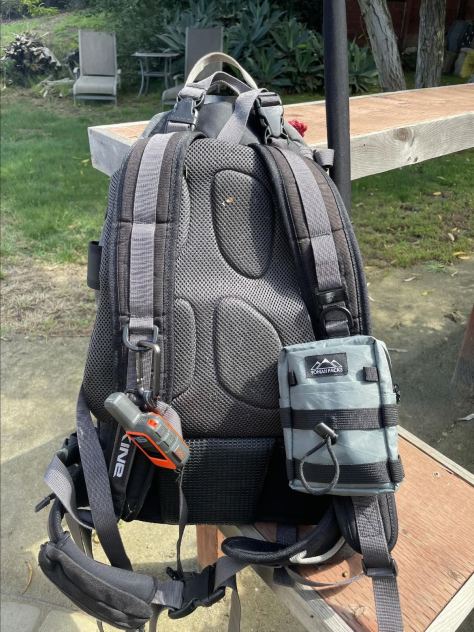Many thanks to Adam (K6ARK) who shares the following article about his portable field radio kit which will be featured on our Field Kit Gallery page. If you would like to share your field kit with the QRPer community, check out this post.
To me, the pinnacle of portable amateur radio involves Summits On The Air (SOTA) activations in particularly remote and hard-to-reach areas. Many require long approaches, difficult climbs, and high-altitude travel to get there, so minimizing the size and weight of my portable radio kit is of utmost importance. To that end, I’ve managed to refine my smallest fully functional kit down to quite a compact and light-weight package.
An MTR2B which operates on 20 m and 40 m. It has been repackaged into a custom-designed 3d printed case is the core of the system. It has been repackaged into a 3d printed case which cuts the weight of the radio by about 60% from the original aluminum and steel case, and shrinks it in thickness by about 50%.
 The key is built-in to the rig – a capacitive touch design I adapted from the M0UKD design.
The key is built-in to the rig – a capacitive touch design I adapted from the M0UKD design.
 Brass cap nuts installed on the corner of the case provide the capacitive sense touch points for the left and right paddles.
Brass cap nuts installed on the corner of the case provide the capacitive sense touch points for the left and right paddles.
 A 9v form-factor rechargeable lithium-ion battery with a USB-C charge port powers the system. The lower voltage reduces my transmit power to 2.5 or 3 watts, but also provides a bit more protection for the final amplifier transistors when my antenna setup is less than ideal. It has sufficient capacity to run this power-efficient little rig for a few hours from a summit.
A 9v form-factor rechargeable lithium-ion battery with a USB-C charge port powers the system. The lower voltage reduces my transmit power to 2.5 or 3 watts, but also provides a bit more protection for the final amplifier transistors when my antenna setup is less than ideal. It has sufficient capacity to run this power-efficient little rig for a few hours from a summit.
 The antenna is a 40m End Fed Half-wave with a matching unit built from an FT50-43 size toroid directly onto an RCA connector and protected with heat shrink tubing. 28 ga PTFE insulated stranded copper wire forms the radiating element, and it’s stored on a down-sized 3d printed winder of my own design.
The antenna is a 40m End Fed Half-wave with a matching unit built from an FT50-43 size toroid directly onto an RCA connector and protected with heat shrink tubing. 28 ga PTFE insulated stranded copper wire forms the radiating element, and it’s stored on a down-sized 3d printed winder of my own design.
 The primary components of the kit weigh in at just 4.8 oz (136 g), and the padded camera case adds another 1.8 oz (51 g). Although the case isn’t particularly light, it provides excellent protection to the rig.
The primary components of the kit weigh in at just 4.8 oz (136 g), and the padded camera case adds another 1.8 oz (51 g). Although the case isn’t particularly light, it provides excellent protection to the rig.


 And because most of the summits I bring this rig to are void of trees, a compact telescopic pole is an essential addition. The one I typically bring packs small and weighs in at just 5.5 oz (156 g) but provides about 10 ft of elevation above the ground. The cap is leashed so I can’t lose it, and the tube is coated in heat shrink for protection when I cram it into the rocks for support.
And because most of the summits I bring this rig to are void of trees, a compact telescopic pole is an essential addition. The one I typically bring packs small and weighs in at just 5.5 oz (156 g) but provides about 10 ft of elevation above the ground. The cap is leashed so I can’t lose it, and the tube is coated in heat shrink for protection when I cram it into the rocks for support.
In the end, it’s quite a capable kit for just 12.1 oz (343 g) of pack weight.
Check out my ‘Sierra Solitude’ video series as a prime example of a trip where this setup is perfect for my needs.
73 DE K6ARK
Readers, do yourself a favor and bookmark Adam’s YouTube channel which is chock-full of SOTA and ultralight radio goodness!

















































